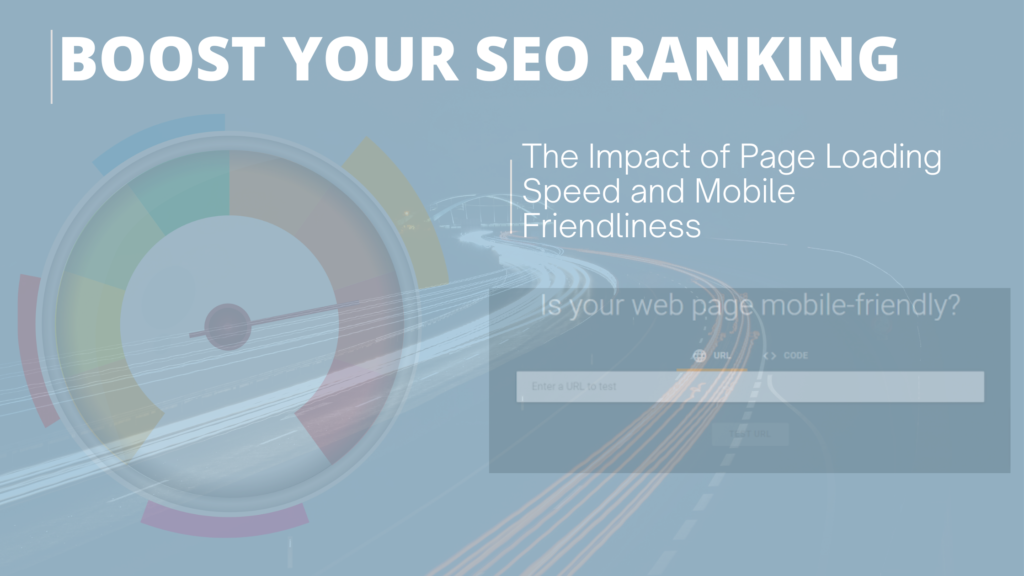In the ever-evolving landscape of the internet, achieving a high search engine ranking has become more crucial than ever. Whether you’re running a blog, an e-commerce site, or a corporate webpage, your online visibility can make or break your success. Two critical factors that play a pivotal role in your SEO efforts are page loading speed and mobile friendliness. In this comprehensive guide, we’ll explore why these elements are so vital and how you can leverage them to improve your website’s SEO, ensuring it becomes a magnet for organic traffic.
The Need for Speed: Page Loading Speed and SEO
1. User Experience: The First Impression
Picture this: you’re searching for information or a product online, and you click on a link that takes forever to load. Frustrating, isn’t it? Slow-loading pages not only irritate users, but they also drive them away. Research shows that 40% of users abandon a website that takes more than 3 seconds to load. This user dissatisfaction has a direct impact on your bounce rate, which, in turn, affects your SEO ranking.
2. Bounce Rates: The SEO Killer
Search engines, like Google, take user behavior into account when determining search rankings. A high bounce rate, caused by slow-loading pages, signals to search engines that your site doesn’t offer a positive user experience. This can lead to a drop in your search rankings, making it even more challenging for potential visitors to discover your content.
3. Mobile Traffic Dominance
With mobile devices overtaking desktops as the primary means of accessing the internet, having a mobile-friendly website is paramount. Mobile users are often on the move, seeking quick access to information. If your website loads slowly on mobile devices, you risk losing a significant portion of your audience.
4. The Need for Speed: Mobile-First Indexing
Google has shifted to mobile-first indexing, which means it primarily uses the mobile version of your site for ranking and indexing. If your mobile site loads sluggishly, it can directly impact your search rankings across all devices. So, optimizing for mobile speed is essential.
Strategies to Improve Page Loading Speed
1. Optimize Images
Images can be the biggest culprits when it comes to slow-loading pages. Compress and resize images to reduce file sizes without compromising quality. You can use various online tools and plugins to help with image optimization.
2. Minimize HTTP Requests
Every element on your page, like images, scripts, and stylesheets, sends a request to the server. Minimizing these requests by reducing unnecessary elements can significantly speed up your page loading times.
3. Use Browser Caching
Leverage browser caching to store frequently used resources on the user’s device. This means the user’s browser doesn’t need to re-download them on subsequent visits, speeding up load times.
4. Content Delivery Networks (CDNs)
CDNs distribute your website’s assets to servers located closer to the user, reducing the physical distance data must travel. This can dramatically improve loading speed, especially for international visitors.
5. Reduce Redirects
Redirects slow down the loading process as they trigger additional HTTP requests. Limit the use of redirects and ensure they are necessary for your site’s functionality.
The Significance of Mobile Friendliness
1. Responsive Web Design
Adopting a responsive web design ensures that your site adapts to different screen sizes and devices seamlessly. Google prefers responsive sites, and they are more user-friendly overall.
2. Mobile Usability
Ensure that your website is easy to navigate and interact with on mobile devices. A smooth, intuitive mobile experience keeps users engaged and can lead to higher conversions.
3. Page Loading Speed on Mobile
The strategies mentioned earlier for improving page loading speed apply to mobile devices as well. Mobile users are often more impatient than desktop users, so optimizing for speed is even more critical for this audience.
4. Google’s Mobile-Friendly Test
Google provides a Mobile-Friendly Test tool that can help you assess your website’s mobile compatibility. It provides recommendations and insights into areas that need improvement.
A Holistic Approach to SEO
In the world of SEO, there are no one-size-fits-all solutions. Improving page loading speed and mobile friendliness should be part of a broader SEO strategy that includes:
1. Quality Content
High-quality, relevant, and engaging content is still king. Combining great content with a fast-loading, mobile-friendly website creates a winning formula for SEO success.
2. On-Page SEO
Optimize your website’s on-page elements, including meta tags, header tags, and keyword usage. These elements are essential for search engine recognition.
3. Backlinks
High-quality backlinks from authoritative sources boost your website’s authority and can improve your SEO ranking. Focus on earning natural backlinks through content quality and outreach.
4. Social Signals
Engaging with your audience on social media platforms can boost your website’s visibility. While social signals don’t have a direct impact on SEO, they contribute to a robust online presence.
5. Regular Updates
Continuously update your website’s content and features to keep it relevant and appealing to both users and search engines.
Conclusion
Page loading speed and mobile friendliness are critical factors for SEO success. They directly impact user experience, bounce rates, and search engine rankings. By optimizing your website for speed and ensuring mobile compatibility, you can create a strong foundation for your broader SEO strategy.
Remember that SEO is an ongoing process. Regularly monitor your website’s performance, adapt to changing algorithms, and stay up-to-date with the latest industry trends to maintain and improve your SEO ranking. Combining a fast-loading, mobile-friendly website with high-quality content and a holistic SEO approach will position your site for success in the competitive online landscape.


Pingback: Unlocking SEO Potential: The Impact of HTTPS Implementation on Website Security and Search Rankings -
Pingback: How Do Search Engines Work?
Pingback: What are most Common SEO Mistakes to avoid?
Pingback: What is technical SEO?
Pingback: How can I improve my website's SEO ranking?
Pingback: What is the importance of mobile optimization in on-page SEO?
Pingback: How do I ensure my site is mobile-friendly